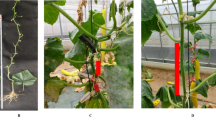Abstract
The two varieties—Bourbon (B) and its natural mutant Bourbon pointu (BP)—of Arabica coffee (Coffea arabica L.) differ by an epigenetic, monolocus, and recessive laurina mutation that results in pleiotropic effects, such as tree dwarfism and tree-shape modification. The objective of the study was to search for the origin of the differences in size and shape of the tree both at the macroscopic (length and number of internodes, branching angle) and at the microscopic levels (size and number of cells within the internode pith). At the macroscopic level, the laurina mutation acted only by decreasing the internode size. Neither the angle of branching nor the number of internodes was influenced by the mutation. At the microscopic level, the mutation lowered mainly the number of cells present along the longitudinal axis of the internode, and, at a lesser extent, the cell height. Especially, the internode size decreasing explained both the tree dwarfism and the tree-shape modification. In fact, the laurina mutation strengthened the dwarfism of plagiotropic internodes when compared to that of the orthotropic ones, and such an impact was mainly due to a strong cell number decrease. To summarize, two major pleiotropic effects of the laurina mutation can be explained only by a modification of the trade-off between meresis and auxesis during the internode growth. This opens new perspectives for the characterization of the other effects at the hormonal level, and then, for the identification of the gene at the molecular level.






Similar content being viewed by others
Notes
Institut de Recherche pour le Développement.
References
Anthony F, Combes MC, Astorga C, Bertrand B, Graziosi G, Lashermes P (2002) The origin of cultivated Coffea arabica L. varieties revealed by AFLP and SSR markers. Theor Appl Genet 104:894–900. doi:10.1007/s00122-001-0798-8
Brown CL, Sommer HE (1992) Shoot growth and histogenesis of trees possessing diverse patterns of shoot development. Am J Bot 79:335–346. doi:10.2307/2445024
Brown CL, Sommer HE, Wetzstein HY (1994) Morphological and histological differences in the development of dwarf mutants of sexual and somatic origin in diverse woody taxa. Trees (Berl) 9:61–66. doi:10.1007/BF00202123
Chevalier A (1947) Les caféiers du globe: III. Systématique des caféiers et faux-caféiers maladies et insectes nuisibles. In: Encyclopédie biologique. P. Lechevalier, Paris
Daykin A, Scott IM, Francis D, Causton DR (1997) Effects of gibberellin on the cellular dynamic of dwarf pea internode development. Planta 203:526–535
Feng S, Martinez C, Gusmaroli G, Wang Y, Zhou J, Wang F, Chen L, Yu L, Iglesias-Pedraz JM, Kircher S, Schäfer E, Fu X, Fan L-M, Deng XW (2008) Coordinated regulation of Arabidopsis thaliana development by light and gibberellins. Nature 451:475–480. doi:10.1038/nature06448
Garrison R (1973) The growth and development of internodes in Helianthus annuus. Bot Gaz 134:246–255. doi:10.1086/336711
Gazzarrini S, Mccourt P (2003) Cross-talk in plant hormone signalling: what Arabidopsis mutants are telling us? Ann Bot (Lond) 91:605–612. doi:10.1093/aob/mcg064
Haarer A (1956) Modern coffee production. Leonard Hill, London
Hallé F, Oldeman R (1970) Essai sur l’architecture et la dynamique de croissance des arbres tropicaux. Masson, Paris
Honda H (1971) Description of the form of trees by the parameters of the tree-like body: effect of the branching angle and the branch length on the shape of the tree-like body. J Theor Biol 31:331–338. doi:10.1016/0022-5193(71)90191-3
Kempf JS, Pickett STA (1981) The role of branch length and angle in branching pattern of forest shrubs along a successional gradient. New Phytol 88:111–116
Krug CA (1949) Mutaçoes em Coffea arabica L. Bragantia 9:1–10
Krug CA, Carvalho A (1951) The genetics of Coffea. Adv Genet 4:127–158. doi:10.1016/S0065-2660(08)60233-3
Krug CA, Carvalho A, Antunes Filho H (1954) Genetica de Coffea. XXI. Hereditariedade dos caracteriscos de Coffea arabica L. var. laurina (Smeathman) DC. Bragantia 13:247–255
Kutschera U (2000) Cell expansion in plant development. Rev Bras Fisiol Vegetal 12:65–95
Kutschera U, Köhler K (1994) Cell elongation, turgor and osmotic pressure in developing sunflower hypocotyls. J Exp Bot 45:591–595. doi:10.1093/jxb/45.5.591
Lécolier A, Besse P, Charrier A, Tchakaloff TN, Noirot M (2009a) Unraveling the origin of Coffea arabica ‘Bourbon pointu’ from La Réunion: a historical and scientific perspective. Euphytica. doi:10.1007/s10681-009-9886-7
Lécolier A, Noirot M, Escoute J, Chrestin H, Verdeil JL (2009b) Early effects of the mutation laurina on the shoot apex functioning of coffee tree and analysis of the plastochron phases: relationships with the dwarfism of leaves. Trees. doi:10.1007/s00468-008-0311-y
Sachs J (1882) Vorlesungen über Pflanzenphysiolgie. Engelmann, Leipzig, p 991
Schöpf J (1954) Untersuchungen über Astreinigung der Selber Kiefer. Forstw Centralblatt 73:275–290. doi:10.1007/BF01819648
Seifert T (2003) Integration von Holzqualität und Holzsortierung in behandlungssensitive Waldwachstums–modelle. PhD thesis at the Science Center Weihenstephan, Technische Universität München, p 314
Sybenga J (1960) Genetics and cytology of coffee. Bibliog Genet 29:217–316
Varossieau WW (1940) On the development of the stem and the formation of leaves in Coffea-species. Ann Jardin Buitenzorg 50:115–198
Acknowledgments
These studies were financially supported by the European Union, the Région de la Réunion and the Institut pour la Recherche et le Développement (IRD). Lécolier Aurélie had an Allocation Régionale de Formation Doctorale. We also thank Mr. Frederic Descroix (CIRAD) for providing BP seeds and Mr Serge Hamon (IRD) for allowing the beginning of this work in the DGPC UMR.
Author information
Authors and Affiliations
Corresponding author
Additional information
Communicated by D. Treutter.
Rights and permissions
About this article
Cite this article
Lécolier, A., Verdeil, JL., Escoute, J. et al. Laurina mutation affected Coffea arabica tree size and shape mainly through internode dwarfism. Trees 23, 1043–1051 (2009). https://doi.org/10.1007/s00468-009-0346-8
Received:
Revised:
Accepted:
Published:
Issue Date:
DOI: https://doi.org/10.1007/s00468-009-0346-8




